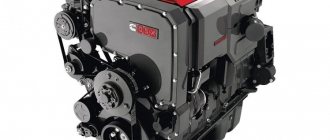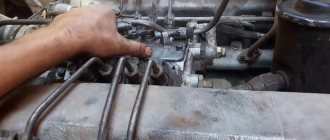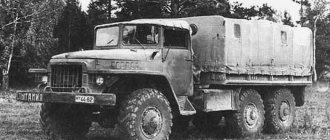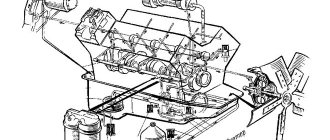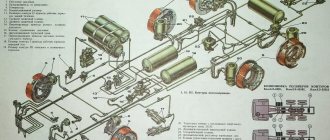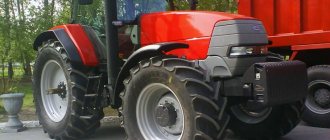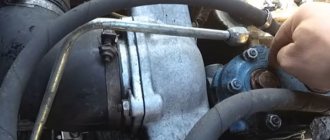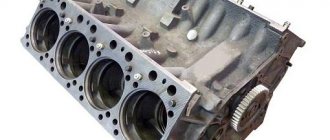The domestic V-shaped, 8-cylinder Kamaz 740 engine begins its history in 1974, when it first rolled off the stocks of the Kama plant. This first modification was marked 740.210 and 740.260 and complied with the Euro-0 environmental standard. Power was 154 and 191 kW (or 210 and 260 hp) respectively. Then there were many stages in the development of this extremely successful diesel engine, and its modern models are capable of producing 420 hp. in the turbocharged version and this is already Euro-4, which indicates a high technological level of the unit. The mileage declared by the manufacturer is 800 thousand km.
Thanks to their high technical characteristics and time-tested reliability, Kamaz 740 engines are installed not only on their own equipment, but also on Ural, ZIL trucks, buses of various brands such as LaZ, LiAZ, etc. The applicability is quite wide. And in the 80s of the last century, these engines were installed on DAF trucks, but unfortunately this cooperation did not last long; the Dutch company eventually developed its own power unit for its own equipment.
Specifications
KAMAZ is a heavy-duty vehicle with a large number of options and modifications. Manufacturer: Kama Automobile Plant KamAZ .
The main domestic competitor of this engine is the YaMZ-236/238 model produced by the Yaroslavl Motor Plant. But each of them occupies its own market niche. The design of the KamAZ-740 engine is similar to the YaMZ engine, but there are a number of design differences. So, the Chelny engine has a separate cylinder head for each cylinder.
Depending on the generation and year of production, KamAZ-740 engines have different environmental standards: from Euro-0 to Euro-5. Next, the main technical characteristics of the 740 power unit and its modifications will be described.
Euro-0 motors | 740.210 and 740.260
| Name | Characteristic |
| Power | 154 kW. for 210 hp and 191 kW for 260l. With. |
| Number of cylinders | 8 |
| Number of heads | 8 |
| Number of valves | 16 |
| Cooling | Liquid |
| Volume | 10.85 (10,850 cm3.) |
| Power supply system | Injection pump 33 YAZDA or 334 YAZDA |
| Cylinder operating order | 1-5-4-2-6-3-7-8 |
Euro 2 motors | 740.31-240 and 740.30-260
| Name | Characteristic |
| Power | 176 kW. for 240 and 191 kW. for 260 |
| Number of cylinders | 8 |
| Number of heads | 8 |
| Number of valves | 16 |
| Cooling | Liquid |
| Volume | 10.85 (10,850 cm3) |
| Power supply system | Fuel injection pump 337-20 YAZDA or 337-21 YAZDA |
| Cylinder operating order | 1-5-4-2-6-3-7-8 |
Euro 2 motors | 740.51-320 and 740.50-360
| Name | Characteristic |
| Power | 235 kW. for 320 and 265 kW. for 360 |
| Number of cylinders | 8 |
| Number of heads | 8 |
| Number of valves | 16 |
| Cooling | Liquid |
| Volume | 10.85 (10,850 cm3) |
| Power supply system | Fuel injection pump 337-20-03 YAZDA or 337-20-04 YAZDA |
| Cylinder operating order | 1-5-4-2-6-3-7-8 |
Euro 4 motors | 740.70 and modifications
| Name | Characteristic |
| Power | 280–420 l. With. |
| Number of cylinders | 8 |
| Number of heads | 8 |
| Number of valves | 16 |
| Cooling | Liquid |
| Volume | 11.67 (11,670 cm3) |
| Power supply system | Fuel injection pump 337-20-03 YAZDA or 337-20-04 YAZDA |
| Cylinder operating order | 1-5-4-2-6-3-7-8 |
The characteristics of KamAZ engines, which are produced by the Kama Motor Plant, are sufficient and are capable of delivering the required power to the truck.
Main characteristics of 740 series power plants
The ancestor of the engine series was the KAMAZ 740 V8 model; the first models of this engine had a volume of 10852 cm3, while the power was developed up to 210 horsepower. Later models came out with power ranging from 180-360 hp. All KAMAZ power plants run on diesel fuel, the choice in its favor is not accidental: firstly, less fuel is consumed, secondly, the engine and its parts are better lubricated, and thirdly, the power plant has more power.
A feature of the operation of KAMAZ engines can also be considered an indicator such as an increased compression ratio compared to gasoline internal combustion engines. Thus, gasoline power plants have a degree of 8-10 units, while the KAMAZ engine has 17 units. In addition, the engines do not have spark plugs, this is due to the specifics of diesel operation. Ignition and combustion in such power plants occurs due to high pressure.
Due to the movement of the piston to the top dead center position, the internal volume decreases sharply, and a sharp increase in pressure and temperature occurs. This is the principle on which a diesel engine operates.
In marking its products, the manufacturer uses various designations that are responsible for the type of power plant:
- The V-cylinders of the engine are arranged in two rows, the angle between which is less than 90°;
- L-cylinders are arranged in two rows, the angle between which approaches 90°;
- R—cylinder arrangement is in-line.
Power plant KAMAZ 740
The Kamaz engine of the 740 modification has a number of advantages and features over its competitors:
- The structure of the motor is such that, with the same characteristics as those of similar manufacturers, it is significantly smaller in size. The motor is a kind of compromise between large, but low-power units that consume a fairly large amount of fuel, and are quite reliable, and powerful, economical, but less reliable and durable.
- The car has become widespread due to its ability to operate in low temperatures. In particular, KAMAZ has no problems starting in the cold season. The motor has a powerful battery and starter, as well as an engine heating system.
- Gas distribution system drive, compressors, hydraulic booster, pump: they operate by transmitting torque from the engine through gears with straight teeth.
Service
Change of oil.
It is recommended to change the oil every 10,000 km, regardless of the frequency indicated in the instructions (this is due to the high sulfur content in Russian diesel fuel, which leads to rapid oxidation of the oil). During long-term operation at low speeds - it is recommended not lower than 1000 rpm - at parking lots, overnight stays, it is recommended to change the oil after 7500 km.
For turbodiesels, starting from Euro-2, it is possible to carry out maintenance at intervals of 20,000 km.
Replacing the air filter.
During daily inspection, inspect the filter elements and replace as necessary.
In difficult conditions, carry out daily cleaning of surfaces from dust and dirt, change filter elements every 3-4 thousand kilometers. If the air filter fails, a lack of air supply to the cylinders leads to incomplete combustion of fuel, which leads to engine failure. Start driving only with a warm engine.
Driving without warming up will lead to replacement of liners and piston rings.
Experts recommend checking the fuel system and adjusting the valves at every service. This will reduce wear on the power unit and can extend its life by another 100 thousand km.
Repairs and malfunctions
Like any power unit, the 740 engine tends to break down.
Our repair specialists will be able to help you with KamAZ engine repairs and order repairs
Most malfunctions are the result of violation of recommendations and maintenance schedules. Before operating the vehicle, we strongly recommend that you study the reference manual for the operation and maintenance of Kamaz engines.
Malfunctions of the 740 engine can be caused by problems in the connecting rod and crank mechanisms and in the mechanics that are responsible for gas distribution. Usual signs: the appearance of dull and rhythmic knocks at the bottom of the engine crankcase, as well as the presence of loud knocks inside the cylinder.
In connecting rod and crank mechanics, problems can be caused by poor damping of the journals inside the crankshaft, as well as wear of the bearings. It is possible for the liners to rotate, as well as jamming inside the crankshaft due to coked oil channels inside each journal, breakage of connecting rods or connecting rod bolts, wear of piston rings, as well as cylinder liners, wear of the holes necessary for the passage of cooling fluid inside the cylinders under the influence of shock vibration .
Knock in the middle of the engine block.
Motor power indicators decrease, fuel and oil consumption increases, and smoke increases due to exhaust gases. Inside the piston grooves, piston rings and cylinder liners burn and wear out. The engine does not start, starts and stalls.
Loss of engine power. The main reason is the presence of water in the fuel. Drain water and sediment from the coarse filter daily. Turn off the engine. Open the drain valve. Turn the valve handle counterclockwise 4 full turns so that the valve drops 2.5 cm. If the amount of fluid drained exceeds 50-60 grams, add fuel to the filter.
Another reason for difficulty starting the engine is air sucking into the fuel lines. It is necessary to check all fuel line connections for leaks.
Contamination of fuel filters (FGOT, FTOT) and fuel intake. Air filter dirty. Rinse the tank, replace the fuel and air filters.
Contact a car service center for engine diagnostics.
Oil leakage
Never operate the engine if the oil level is above or below the marks.
Check the oil level after turning off the engine no earlier than 5 minutes after stopping. Increased engine temperature.
Do not overheat the engine above 100°C.
Do not add cold coolant to a hot engine, as this may cause engine failure.
Strong vibration and engine noise.
Knock of valves in the engine timing belt. Violation of adjustments of the gas distribution mechanism and engine fuel injection pump. Adjust thermal clearances and fuel injection advance angle. Carry out routine maintenance. Contact a car service for diagnostics.
An increase in the smokiness of exhaust gases with a specific bluish tint when they exit the muffler and a drop in oil pressure are a consequence of a malfunction of the lubrication system.
Engine lubrication system Kamaz 740
All Kamaz 740 diesel engines have a combined lubrication system with a so-called “wet” sump. It supplies oil under pressure upward to the camshaft and crankshaft bearings, to the rocker arm bushings, to the bearings of the compressor and injection pump. The upper spherical pushrods are also provided with lubrication by pulsating oil.
The lubrication system of all Kamaz 740 engines includes:
- Oil pump,
- Oil sump,
- Full flow oil filter,
- Centrifugal oil filter,
- Radiator,
- Oil channels in the cylinder block, in the cylinder heads, in the front cover and flywheel housing,
- External oil lines,
- Oil filler neck,
- valves,
- A control system that ensures the normal operation of the lubrication system.
Diagram of the Kamaz 740 lubrication system.
Oil from the crankcase is supplied through the oil receiver to the oil pump, from its discharge part through the oil channel in the right wall of the cylinder block it enters the filter, where it is cleaned, then the purified oil enters the main line and from there through the outlet channels it reaches the main bearings crankshaft, rocker arm bushings and top tips of pushrods.
The crankshaft connecting rod bearings are lubricated through holes inside the shaft itself, where oil enters from the main journal. Oil scraper rings, after removing oil from the cylinder walls, direct it to the piston, where it lubricates the piston pin supports and the connecting rod upper head bearing.
Through the channels of the rear and front walls of the cylinder block, under pressure, oil is supplied to the bearings of the compressor and injection pump.
The fluid coupling switch, which controls the fan drive, is lubricated from the main line.
After passing through the oil radiator section, the oil enters the centrifugal filter and from there flows into the engine crankcase. If the oil radiator switch valve is closed, then after the centrifugal filter, the oil, bypassing the radiator, enters the crankcase. All honeycomb parts and components of the Kamaz 740 engine are lubricated from splashes and oil vapors.
Major renovation
order repairs
Overhaul of the KamAZ-740 engine is a rather complex procedure that requires knowledge of the design, technical standards and special equipment to carry out these operations. There are instructions for carrying out major overhauls of power units, which were developed by the manufacturer; they quite accurately describe all the subtleties of the process.
Sequence of actions for carrying out restoration operations on the KamAZ-740 engine:
- First, the faulty motor is disassembled to determine defects.
- The next step is fault diagnosis. This includes diagnostic work on the crankshaft, cylinder heads, camshaft, water and oil pumps. When carrying out repair and restoration work, the high pressure fuel pump must be restored.
- The next stage of power unit repair is boring the block and crankshaft. It is worth noting that the KamAZ crankshaft is a fairly strong part, so this is not always required. But with the block, things are usually much worse. In any case, you will have to bore the cylinders, but this does not always help. So, if the motor is more than 20 years old, then the only solution is to line the block.
| Name / Repair | 1 | 2 | 3 | 4 |
| Crankshaft | 0.25 mm | 0.50 mm | 0.75 mm | 1.00 mm |
| Cylinder block | 120.5 mm | 121.0 mm | 121.5 mm | ST - sleeve |
- An integral stage of engine restoration is the repair of all heads, of which KamAZ has eight. Thus, guide bushings are often changed, which are first turned on a lathe. The valves are chamfered and adjusted, and the seats are subjected to a roller cutter.
- The next step is polishing the camshaft cams. This is done on a lathe using a special paste and sandpaper.
- Next comes the stage of repairing the water and oil pump. Engine repair specialists are reluctant to repair these parts, but because they are particularly expensive, they have to in order to retain customers. As mentioned earlier, only some elements of the products can be replaced. So, the impeller, shaft assembly, cuff and bearings are replaced.
- Before you begin the crankshaft installation procedure, it is necessary to carry out the balancing process. The clutch is attached to the crankshaft and rotated, installing special weights. If this procedure is not carried out, then during operation the shaft will become unbalanced, which will lead to breakage of the yokes and connecting rods with liners.
- The last stage can rightfully be considered assembly. This process is quite long as it takes almost the whole day. The crankshaft is laid down and goes through the “banding” process. This is the procedure for connecting the crankshaft to the piston group and installing the liners, both main and connecting rod. Next, the oil pump and pump are assembled. All small parts are collected. The last to be installed are the cylinder heads, valve covers, injection pump and exhaust system.
- After the engine is assembled, it needs to be run in. This is done only when it is hot. The power supply system and exhaust system are connected to the power unit, and then it is started, adjusting the speed, and the valve clearances are periodically set.
After the KamAZ power unit is assembled, it is installed on the vehicle and tested on the move.
Repair and maintenance of KamAZ-740 engines is quite simple and does not require any special skills or abilities of specialists. Unlike its Western counterparts, the KamAZ engine has simple design features and does not have complex electronics.
order repairs
Troubleshooting Methods
Main malfunctions of KamAZ-740 engines
The KamAZ-740 engine operates using diesel fuel. It is not recommended to independently repair diesel power units. But in some cases, problems with starting the engine can be eliminated without the help of specialists. There are several reasons that cause engine starting problems.
Lack of fuel in the fuel tank . This reason is the most common. And you can solve it by refueling the car. Important: after filling the tank, pump diesel fuel into the power system.
Air entering the power system . To eliminate air in the power system, you need to identify areas of depressurization. After the tightness is restored, the system needs to be pumped.
Freezing of fuel pipes . If ice forms in the pipes, it is necessary to warm up the fuel filters by placing a cloth soaked in hot water on them.
Summary
The KamAZ-740 engine has excellent technical characteristics, which made it popular not only in Russia, but throughout the world.
Production of 740 engines continues today. The KAMAZ engine plant produces a large number of engines, and even plans to release a new engine labeled 740.80-300.
This is a 5th generation power unit with Euro-5 environmental standards, which will have a new injection system, which, according to the designers, will change the idea of turbodiesels in trucks. Power will vary from 500 to 800 horsepower.
Engine cooling system Kamaz 740
A closed-type liquid system with forced circulation is responsible for cooling the Kamaz 740 diesel engine. Its main elements:
- Radiator,
- Water pump,
- Thermostats,
- Fluid coupling of the fan drive and its switch,
- Expansion tank,
- Bypass pipes and pipes,
- Blinds.
Scheme of the Kamaz 740 cooling system.
The centrifugal pump ensures constant circulation of coolant in the system while the engine is running. First, the liquid is supplied to the water cavities of the left and right rows of cylinders.
During cooling of the outer surfaces of the cylinder liners, coolant enters the water cavities of the cylinder heads through channels in the upper mating planes of the block.
After passing through the cylinder heads, the liquid is supplied through the pipes to the thermostat and from there, depending on its temperature, it goes either to the radiator to reduce the temperature, or to the water pump, from where it goes to the cooling system for the next round.
The operating temperature of the coolant in the Kamaz 740 engine cooling system is 80-98 degrees C. Automatic thermostats and a fan fluid coupling switch are responsible for the thermal conditions of the engine. And depending on the temperature, the fan turns on for additional cooling of the liquid or it is in circulation all the time if the temperature is within the lower limits.
For the cold season (which is very important for our country) and to quickly warm up the engine and bring it to operating temperature, there are blinds installed in front of the radiator and they prevent the incoming air flow from excessively cooling the liquid while the car is moving.
